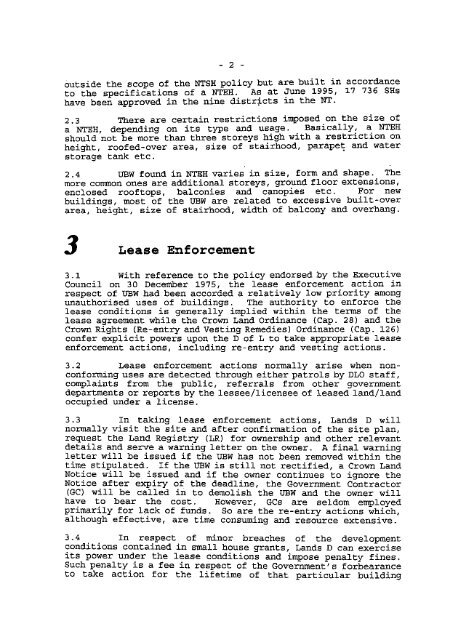Introduction - HKU Libraries - The University of Hong Kong
Introduction - HKU Libraries - The University of Hong Kong
Introduction - HKU Libraries - The University of Hong Kong
You also want an ePaper? Increase the reach of your titles
YUMPU automatically turns print PDFs into web optimized ePapers that Google loves.
- 2 -outside the scope <strong>of</strong> the NTSH policy but are built in accordanceto the specifications <strong>of</strong> a NTEH. As at June 1995, 17 736 SHshave been approved in the nine districts in the NT.2.3 <strong>The</strong>re are certain restrictions imposed on the size <strong>of</strong>a NTEH, depending on its type and usage. Basically, a NTEHshould not be more than three storeys high with a restriction onheight, ro<strong>of</strong>ed-over area, size <strong>of</strong> stairhood, parapet and waterstorage tank etc.2.4 UBW found in NTEH varies in size, form and shape.^ <strong>The</strong>more common ones are additional storeys, ground floor extensions,enclosed ro<strong>of</strong>tops, balconies and canopies etc. For newbuildings, most <strong>of</strong> the UBW are related to excessive built-overarea, height, size <strong>of</strong> stairhood, width <strong>of</strong> balcony and overhang.3 Lease Enforcement3.1 With reference to the policy endorsed by the ExecutiveCouncil on 30 December 1975, the lease enforcement action inrespect <strong>of</strong> UBW had been accorded a relatively low priority amongunauthorised uses <strong>of</strong> buildings. <strong>The</strong> authority to enforce thelease conditions is generally implied within the terms <strong>of</strong> thelease agreement while the Crown Land Ordinance (Cap. 28) and theCrown Rights (Re-entry and Vesting Remedies) Ordinance (Cap. 126)confer explicit powers upon the D <strong>of</strong> L to take appropriate leaseenforcement actions, including re-entry and vesting actions.3.2 Lease enforcement actions normally arise when nonconforminguses are detected through either patrols by DLO staff,complaints from the public, referrals from other governmentdepartments or reports by the lessee/licensee <strong>of</strong> leased land/landoccupied under a license.3.3 In taking lease enforcement actions, Lands D willnormally visit the site and after confirmation <strong>of</strong> the site plan,request the Land Registry (LR) for ownership and other relevantdetails and serve a warning letter on the owner. A final warningletter will be issued if the UBW has not been removed within thetime stipulated. If the UBW is still not rectified, a Crown LandNotice will be issued and if the owner continues to ignore theNotice after expiry <strong>of</strong> the deadline, the Government Contractor•(GC) will be called in to demolish the UBW and the owner willhave to bear the cost. However, GCs are seldom employedprimarily for lack <strong>of</strong> funds. So are the re-entry actions which,although effective, are time consuming and resource extensive.3.4 In respect <strong>of</strong> minor breaches <strong>of</strong> the developmentconditions contained in small house grants, Lands D can exerciseits power under the lease conditions and impose penalty fines.Such penalty is a fee in respect <strong>of</strong> the Government's forbearanceto take action for the lifetime <strong>of</strong> that particular building
















